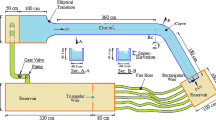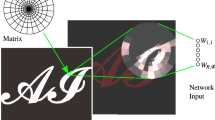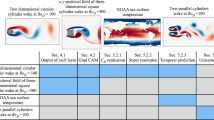Abstract
An estimation of the fluctuations in the passive-tracer concentration for the turbulent wake behind an airfoil is presented. The estimation is based on experimental modelling using Radial Basis Function Neural Networks. For the experiment the fluctuations of the concentration in the turbulent wake were recorded with a visualization method. The records of the concentration in the selected regions of the turbulent wake were used as the input and output regions for the training and estimation with neural networks. The uncertainty of the estimation increased with increasing distance between the input and the output regions. The power spectra, the spatial correlation functions and the profiles of the concentration were calculated from the measured and estimated fluctuations of the concentration. The measured and estimated concentration power spectra were in reasonable agreement. The measured and estimated spatial correlation functions and the profiles of the concentration showed a similar agreement.
Similar content being viewed by others
References
Aider, J.L. and Westfried, J.E., Visualization and PDF of the Fluctuations of a Passive Scalar in a Turbulent Görtler Flow. FED, Experimetal and Numerical Flow Visualization, ASME 218 (1995) 123–130.
Balu, M., Balachandar, R. and Wood, H., Concentration estimation in two-dimensional Bluff Body Wakes using image processing and neural networks, J. Fluid Struct. 8(2–3) (2001) 121–140.
Chatzipanagiotidis, A. and Olivari, D., Pollutant dispersal downstream of a hill in different wind conditions. J. Wind Eng. Ind. Aerodyn. 64(2–3) (1996) 233–248.
Chen, S., Cowan, C.F.N. and Grant, P.M., Orthogonal least squares learning algorithm for radial basis function networks, IEEE Trans. Neural Networks 2(2) (1991) 302–309.
Devenport, W.J, Muthanna, C., Ma, R. and Glegg, S.A.L., Two-point descriptions of wake turbulence with application to noise prediction. AIAA J. 39(12) (2001) 2302–2307.
Dibike, Y.B., Minns, A.W. and Abbot, M.B., Applications of artificial neural networks to the generation of wave equations from hydraulic data. J. Hydraul. Res. 37(1) (1999) 81–97.
Faller, W.E. and Schreck, S.J., Neural networks: Applications and opportunities in aeronautics, Prog. Aerosp. Sci. 32(5) (1996) 433–456.
Ferre-Gine, J., Rallo, R., Arenas, A. and Giralt, F., Extraction of structures from turbulent signals, Artif. Intell. Eng. 11(4) (1997) 413–419.
Gad-el-Hak, M., Pollard, A. and Bonnet, J.P., Flow Control. Fundamentals and Practices, Springer, Berlin (1998).
Gerdes, F. and Olivari, D., Analysis of pollutant dispersion in an urban street canyon. J. Wind Eng. Ind. Aerodyn. 81(1) (1999) 105–124.
Gillies, E.A., Low dimensional control of the circular cylinder wake. J. Fluid Mech. 371 (1998) 157–180.
Giralt, F., Arenas, A., Ferre-Gine, J., Rallo, R. and Kopp, G.A., The simulation and interpretation of free turbulence with a cognitive neural system. Phys. Fluids 12(7) (2000) 1862–1869.
Gomm, J.B. and Yu, D.L., Selecting radial basis function network centers with recursive orthogonal least squares training. IEEE Trans. Neural Networks 11(2) (2000) 306–314.
Grabec, I., Experimental modeling of physical laws, Eur. Phys. J. B. 22 (2001) 129–135.
Grabec, I. and Sachse, W., Synergetics of Measurement, Prediction and Control, Springer, Berlin, (1997).
Grisch, F. and Bresson, A., Radical imaging and temperature mapping in turbulent gaseous flowfields. CR Acad. Sci. IV-Phys. 7 (2001) 1037–1047.
Han, M. and Xi, J., Efficient clustering of radial basis perceptron neural network for pattern recognition. Pattern Recognition 37(10) (2004) 2059–2067.
Jambunathan, K., Fontama, V.N., Hartle, S.L. and Ashford-Frost, S., Using ART2 networks to deduce flow velocities, Artif. Intell. Eng. 11 (1997) 135–141.
Keles, R.S., Active control of transition to turbulence in the wake of a cylinder. Aircraft Design 3 (2000) 1–15.
Kimura, I., Susaki, Y., Kiyohara, R., Kaga, A. and Kuroe, Y., Gradient-based PIV using neural networks. J. Visual-Japan 5(4) (2002) 363–70.
Landau, L.D. and Lifshitz, E.M., Fluid Mechanics, Pergamon, Oxford, (1987).
Law, A.W.K. and Wang, H., Measurement of mixing processes with combined digital particle image velocimetry and planar laser induced fluorescence. Exper. Therm. Fluid Sci. 22 (2000) 213–229.
Lee, C., Kim, J., Babcock, D. and Goodman, R., Application of neural networks to turbulence control for drag reduction. Phys. Fluids 9(6) (1997) 1740–1747.
Liang, D.F., Jiang, C.B. and Li, Y.L., Cellular neural network to detect spurious vectors in PIV data. Exp. Fluids 34(1) (2003) 52–62.
López Peña, F., Duro, R.J. and Sánchez Simón, M., Detecting coherent structures in a turbulent wake by using delay based networks. Comp. Stand. Inter. 24(2) (2002) 171–184.
Milano, M. and Koumoutsakos, P., Neural network modeling for near wall turbulent flow. J. Comput. Phys. 182(1) (2002) 1–26.
Panigrahi, P.K., Dwivedi, M., Khandelwal, V. and Sen, M., Prediction of turbulence statistics behind a square cylinder using neural networks and fuzzy logic. J. Fluid. Eng-T. ASME 125(2) (2003) 385–387.
Picard, C. and Delville, J., Pressure velocity coupling in a subsonic round jet. Int. J. Heat Fluid Fl. 21(3) (2000) 359–364.
Sarghini F., de Felice G. and Santini, S., Neural networks based subgrid scale modeling in Large Eddy Simulations. Comp. Fluids 32(1) (2003) 97–108.
Simoens, S. and Ayrault, M., Concentration Flux Measurements of a scalar quantity in turbulent flows. Exp. Fluids 16 (1994) 273–28.
Spalart, P.R., Strategies for turbulence modelling and simulations. Int. J. Heat Fluid Flow 21 (2000) 252–263.
Tao, L., Rajagopal, K.R. and Chen, G.Q., Discrete large Eddy Simulation. Commun. Nonlinear Sci. & Numer.l Simulation 6(1) (2001) 17–22.
Yuan J.L. and Fine, T.L., Neural-network design for small training sets of high dimension. IEEE Trans. Neural Networks 9(2) (1998) 266–280.
Author information
Authors and Affiliations
Corresponding author
Rights and permissions
About this article
Cite this article
Hočevar, M., Širok, B. & Grabec, I. A Turbulent-Wake Estimation Using Radial Basis Function Neural Networks. Flow Turbulence Combust 74, 291–308 (2005). https://doi.org/10.1007/s10494-005-5728-4
Received:
Accepted:
Issue Date:
DOI: https://doi.org/10.1007/s10494-005-5728-4




